ONEIDA COMMUNITY TIMELINE
1768: Essay Concerning Human Understanding by John Locke was published.
1769: Dartmouth College was founded as a school of Christian Congregationalist theology and the liberal arts in Hanover, New Hampshire.
1776: Propertied colonialists cited Locke’s “natural rights” philosophy in their Declaration of Independence, asserting their inalienable right to “life, liberty and the pursuit of happiness” and to combine as the United States of America.
1790-1840: A “Second Great Awakening” of Protestant religious revivalism pulsed through the outlying Anglo-Scottish settlements in the new United States, particularly New York state and the Ohio River valley.
1784-1830: Following the 1783 Treaty of Paris, many Oneida and other Haudenosaunee people were driven out of New York state.
1822: Yale Theological Seminary, with a curriculum of Congregationalist Christian theology, was established by Yale College in New Haven Connecticut.
1830: The Indian Removal Act was adopted as law by the United States government.
1831: Charles Finney and others led Christian revival meetings throughout New York state and the northeastern United States.
1831: A revivalist religious meeting was held at the Noyes home at Putney, Vermont. Shortly thereafter, the recent Dartmouth College graduate John H. Noyes decided to study theology at Andover Theological Seminary.
1832: Noyes transferred from Andover to the Yale Theological School.
1833: Noyes professed Christian Perfectionism, citing Paulist and other early Christian communalist practices. He was subsequently suspended as a Congregationalist minister and asked to withdraw from Yale Theological School.
1841: Noyes, John Skinner, George Cragin, Mary Cragin, John Miller and others formed the Society of Inquiry at Putney, based on a theology of Perfectionism.
1843: The Society of Inquiry members, now numbering thirty-five persons, re-characterized themselves as the Putney Corporation with pooled resources totaling $38,000, including funds inherited by Noyes and his siblings from their late father.
1844: Explanatory Notes upon the New Testament by John Wesley was published.
1846: A Statement of Principles was drafted for the Putney Community. George Cragin, Harriet Noyes, Charlotte Miller, Harriet Skinner, Mary Cragin, John Skinner, and John Miller, pledged “to John H. Noyes as such we submit ourselves in all things spiritual and temporal, appealing from his decisions only to the spirit of God.”
1847: Perfectionist conventions were held in upstate New York (Lairdsville and Genoa) and attended by individuals and groups from New England, New Jersey and New York. Some attendees, including the Putney Community, reconstituted themselves as the communal Oneida Association and took up residence on land obtained by Jonathan and Lorlinda Burt, formerly part of the Oneida tribal Reserve in central New York state.
1848: The State of New York adopted the Married Women’s Property Act that provided limited rights to real property but not to wages.
1850: The original Italianate “Mansion House” was built at Oneida.
1852 (March): Oneida Community rescinded its practice of complex marriage.
1852 (December): Oneida Community resumed its practice of complex marriage.
1855: The Commonwealth of Massachusetts adopted a limited Married Women’s Property Act.
1860: The Oneida Community borrowed $30,000 to construct a large brick water-powered factory along Sconondoa Creek.
1861: The United States descended into civil war. No one from the Oneida Community was drafted into the Union army, but at least one member, Edwin Nash, enlisted.
1863: On Liberty by John Stuart Mill was published.
1865: Noyes renounced “free love” and asserted “permanent union” in marriage.
1877: A “new house” was designed for the Mansion House site to accommodate the Wallingford branch, but it was not completed due to lack of funds.
1879 (August): Oneida Community abandoned complex marriage. Female members of commune were encouraged to assume the surnames of their monogamous partners.
1880: The Oneida Community voted to transfer its communal property to a joint-stock corporation owned by shareholders.
1881 (January 1): Oneida Community Limited assumed control of communal assets, formally ending the commune; many members dispersed.
FOUNDER/GROUP HISTORY
Christian Perfectionism has a complex history of development. Modern conceptualizations draw from the teachings of John Wesley (and Methodism), who proposed that “instantaneous deliverance from all sin” was possible by living in accordance with the “ordinances of God.” Thereby, the Wesleyan could live a sinless life. Wesley grounded his theology in epistles of the Christian apostle Paul (Wesley 1827, 1844, 1847).
During the eighteenth and nineteenth centuries, the worldview that asserted the “natural rights” of human agency that acted in accordance with divine law proliferated in Europe and its North American colonies. The writings of notable “natural rights” theorists, such as John Locke and John Stuart Mill, were kept in the Oneida Community reading room and discussed in their newsletter (Locke 1768a, 1768b; Mill 1863, 1866; Circular 1869:375-76).
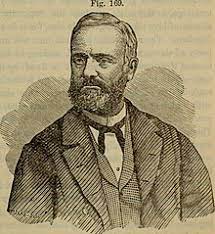
John Humphrey Noyes (1811-1886) [Image at right] is generally acknowledged as the principal leader of the Oneida Community. He was born in Brattleboro, Vermont, to John Noyes and Polly Hayes. The elder Noyes was a moderately prosperous capitalist and one-time Congressional representative for the state. John H. Noyes attended Dartmouth College and after graduation attended Andover Seminary and then the Yale College divinity school. Following expulsion from Yale College, ostensibly for his Perfectionist beliefs, Noyes returned to the family home in Putney, Vermont. There, three of his siblings (Harriett, Charlotte, and George), as well as his mother Polly, joined him in Perfectionist belief and, using funds inherited from the late father, formed the Putney Association. In 1847, that group decamped to central New York, in part to avoid prosecution. Noyes resided at Oneida, New York until 1878 when he reportedly fled during the night of June 27 for Niagara Falls, Ontario, Canada, to escape possible prosecution for polygamy. Noyes remained at Niagara from 1878 until his death in April 1886. His body was returned to Oneida and is buried in the Community cemetery (Teeple 1985:2-3; G. W. Noyes 1931:25-33, 46-62).
As the Second Great Awakening pulsed during the early decades of the nineteenth century, Wesleyan thought found sympathetic minds in New England and upstate New York. Thereby a youthful John Humphrey Noyes (who had studied at Congregationalist-led Dartmouth and Yale colleges and Andover Seminary) encountered Perfectionism and was soon enthralled by it. That enthusiasm interrupted his divinity studies at Yale Seminary, specifically when he incorporated Perfectionist theology in his sermons to a Free Church congregation at North Salem, Connecticut. Noyes’s Perfectionist preaching drew the ire of some Free Church congregants and then of the Association of the Western District of New Haven County, which rescinded his license to preach. Noyes left New Haven for New York City where he attempted to meet with but was rebuffed by Charles Finny, one of the principal agents of the Great Awakening. Noyes knocked about New York for a time, becoming increasingly desolate, until he was rescued back to his father’s home in Vermont by a family friend (Parker 1973:22-29).
During this same period, and following a series of Perfectionist meetings held in central New York state, in 1847, Jonathan Burt, Lorlinda Burt, Daniel Nash, Sophia Nash, Joseph Ackley, Julia Ackley, and Hial Waters, formed the Oneida Association on land obtained by Burt from the State of New York. Joseph Ackley later recalled thinking that they had been “called of God …to build up a society where the love of God would be the prevailing spirit.” (Teeple 1985:xv)
In fact, the land had been a part of the Oneida Nation (Haudenosaunee) Reserve in central New York and near the site of the historic Oneida village of Kanonwalohale (now named Oneida Castle). The property included woodland, cultivated land, and a saw mill that Oneida nationals had built along Oneida Creek. During the 1790s and first decades of the 1800s, the Oneida people were compelled to concede their land in central New York to the state government, which intended to provide it to European settlers (OIN 2019).
In 1848, the Perfectionist Oneida group invited co-religionists living in Vermont to join them in central New York. The Vermont group included John H. Noyes, Harriet Holton Noyes, George Cragin, Mary Cragin, John Skinner, and Harriet Noyes Skinner. The merged groups renamed themselves the Oneida Community.
Although official histories written or commissioned by his son Pierrepont Burt Noyes and nephew George Wallingford Noyes, present John Humphrey Noyes as founder and leader of the Oneida Community, the documentary record suggests that he was one of several acknowledged leaders who only later was asserted (or asserted himself) to be first among equals.
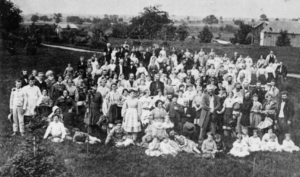
During its first five years (1848-1853), the Community grew to include 134 adults. [Image at right] In 1868, they reported 280 members at Oneida; thirty-five at their Willow Place site; eighty-eight in the branch at Wallingford, Connecticut; and ten in New York City, where they kept a business office on lower Broadway. By 1872, membership at Oneida had declined to 205 at Oneida; nineteen at Willow Place; and forty-five in Wallingford. By the late 1870s, they had relocated all members to Oneida and group population hovered around 200. From 1850 through 1879, more than 150 members left the commune (Circular 1868:24; Oneida Circular 1872:9; “Ledger Showing Settlement, November–December 1880;” “Receipts and settlements with seceders” 1855-1892).
Members were primarily societal refugees from other parts of the northeast United States (Nordhoff 1875:263-64). The commune lived as an extended cooperative family, sharing property and affections with each other. Their polyamorous relationships were characterized as “Complex Marriage” and promoted as a means to civil equality and explicitly to free women from the slave-like conditions of coverture, which was law in many northeastern American states.
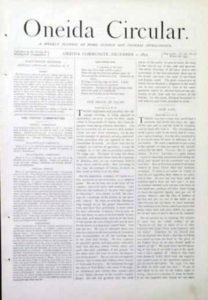
H. Noyes was a regular contributor to the Community’s newsletters and, according to those publications, wrote about theology and current affairs and presented weekly talks meetings in the great hall of their Oneida residence (c.f. every issue of The Circular and Oneida Circular). [Image at right]
Initial efforts in subsistence farming were unsuccessful, and the commune turned its economic focus to market horticulture and light manufacturing. They produced and sold preserved fruits and vegetables, silk thread, and iron-jawed animal traps (c.f. Oneida Circular 1868:8).
As their manufacturing operations expanded, the Community became a significant regional employer, especially of young women, hiring year-round and seasonal workers in the Community silk factory, cannery, sawmill, and metalworking shop. Most operations were conducted at a water-powered Willow Place mill complex built along the Sconondoa Creek. These market-driven operations became the central activity of the commune and were cited as proof of the theological righteousness of the “business communism” and espoused by Noyes and others throughout the 1860s and 1870s (Circular 1864:52; Oneida Circular 1872:242; Oneida Circular 1873:14).
The Community’s dependence upon waged employees and market exchange of manufactures was undermined by the same stressors affecting the rest of the nineteenth century capitalist world. Especially influential was the great depression of 1873-1880. The collapse of markets and increase in debt incurred before, during, and as a result of the collapse left the Community insolvent. That insolvency exacerbated the growing social inequities within the Community and prompted the leaders (who held the legal title to the Community’s property) to propose transferring all assets to a joint-stock company, which would be sold as shares to former members. The Oneida Community formally dissolved on December 31, 1880 (“Record of the proceedings of the Commission” 1880)
The failure of the Community’s “business communism” prompted many members to leave Oneida. Some attempted to reconstitute the commune in southern California. Others stayed on in Oneida as employees or managers of the company’s remaining metalworking operation. A few leaders of the commune became major shareholders, and J.H. Noyes’s son P.B. Noyes ultimately became chief executive of Oneida Community Ltd.
The principal residential buildings and the 1860 factory have remained extant at Oneida. The residential Mansion House complex is used as rental apartments and listed as a National Historical Landmark.
DOCTRINES/BELIEFS
Central to the Oneida Community’s belief system was the premise that persons were capable of living in a Perfect state of sinlessness, with proscribed behaviors obviated by Christian communal practices. This Perfectionist belief system was their interpretation of early Christian communities depicted in Pauline New Testament epistles. In this, they drew directly from the writings of John Wesley. Perfectionists believe that if persons follow the perceived “ordinances of God” they can lead sinless, “perfect” lives. This belief arose in contradistinction to other Protestant Christian beliefs, namely that human beings were inherently fallible and capable of sin.
Upon their foundational belief in sinlessness, the Oneida Community constructed a series of associated beliefs, which they conceptualized as following from divine “ordinances” and specifically practices described in various epistles written by the Christian apostle Paul (c.f. Hinds 1908:154-207; Parker 1973:89-119). First among those was living in community as civil and economic equals. That equality required full and equal participation of women in all aspects of communal life, whose economic and political equality in the outside world was constrained by law. Actualizing that sexual equality was the practice of “complex marriage” and the abolition of monogamous “special love.” Further enabling the full participation of women in the community, men were expected to practice a form of birth control they called “male continence” (Parker 1973:177-89).
In time, Noyes conceptualized the social stratification of “ascending fellowship” within the Community. Noyes himself claimed to be in regular communication with divine predecessors, specifically the apostle Paul, and thereby most perfect of the group. As the Community matured in the late 1860s and early 1870s, it further articulated “ascending fellowship” as an inherited trait. Following on that biological determinism, the Community embarked on a eugenic program they described as “stirpiculture,” through which the more perfect among them would breed new Perfectionists. A committee of Community leaders received applications from prospective couples and either approved or denied requests to procreate. Fifty-eight children were born out of this process, including thirteen by Noyes with thirteen different women members (Parker 1973:253-64).
Mainline Christians denounced the Oneida Community’s practice of complex marriage as simply “free love” by another name. In practice, complex marriage was a communal life in which all men and all women acted as partners. Complex marriage effectively abolished the unequal property relationships then normative in nineteenth century law between men and women by abolishing the nuclear family as a basic economic unit. Individuals were discouraged from developing “special love” (pair bond) relationships with each other, but were not dissuaded from polyamorous relationships. Reportedly, sexual relationships in the Community were consensual, and combined with the birth control practice known as male continence to effectively limit child births. Complex marriage thereby enabled more equitable participation by women in communal affairs (Noyes 1849 [1931], 116-22; New York Times, August 10 1878; American Socialist 1879:282).
More importantly, however, the framework of “complex marriage” was the premise of the entire set of communitarian lifeways, and challenges to complex marriage threatened to undermine those practices, too. At several points in the Community’s existence, it voted to rescind the practice and to follow traditional marriage practices. In each of those instances, except the last instance in 1879, the Community recognized the existential threat that traditional marriage posed to their commune and subsequently decided to reverse itself and reinstitute “complex marriage” and the shared economy it enabled.
Fundamental to achieving Perfection was the Community’s conduct as an economic unit within the larger societal frame of industrial production and market exchange. Noyes and other Community leaders viewed financial success of the Community as an important proof of their theological probity, which Noyes and some others eventually described as “business communism.” The prolonged economic decline and especially the Great Depression of 1873-1880 greatly undermined that assertion and exacerbated internal tensions, leading to the Community’s dissolution in 1880 (Coffee 2019:8-12).
RITUALS/PRACTICES
“I believe this is the gospel method of saving people from sin, and the old Primitive Church way. In respect to marriage Paul did not forbid it, but claimed the right of controlling and checking it by moderate measures, and set the standard of the resurrection, ‘where they neither marry nor are given in marriage’ as the ultimate state” (John Humphrey Noyes, “Tobacco Reform, Home Talk, 1853,” Circular, March 28 1868).
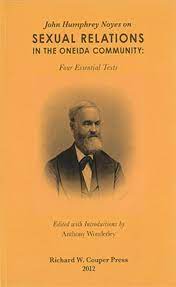
Complex Marriage sanctioned episodic polyamorous heterosexual relationships among members, ostensibly as an equitable alternative to the “special love” of monogamy in which women were subordinate to men. Although this non-monogamous love was officially advocated, the specific sexual activity of members was monitored by commune elders, who sanctioned liaisons and sometimes “initiated” the sexual activity of adolescent youth. [Image at right]
Weekly community meetings in the main hall of their Mansion House were venues for readings or sermons by John Humphrey Noyes and other leaders and for the discussion of communal business and individual duties (c.f. any issue of The Circular or Oneida Circular).
Community bonds and discipline were maintained through the practice of public and holistic “mutual criticism” meetings, during which individuals and practices perceived as transgressing Community principles were critiqued. Transgressors were addressed by their fellow members and especially by most-perfect elders, thereby reinforcing proper behavior and thinking. In a pamphlet about mutual criticism, they wrote that “our object being self-improvement, we have found by much experience that free criticism – faithful, honest, sharp, truth-telling – is one of the best exercises for the attainment of that object” (Mutual Criticism 1876:19). Conversely and perhaps instead revealing its own Whiggish perspective, the August 11, 1878 New York Times reported “that Noyes could bind his followers together by the bond of mutual hate stamps him as a man of real, if perverted, genius.”
We are in suffering, but it is not caused by quarreling among ourselves; the Community is not hell in that respect. Everybody sees that we live in peace with one another, to a very remarkable extent. The tribulations that we have, are that deep kind of discipline of spirit by which God is refining, purifying and perfecting our characters. It would be very pleasant if we could hold up to the world a picture of unalloyed happiness; but until we are perfected it is a great deal better for us to have hard times. We ought not to wish to deceive people with the idea that it is nothing but child’s play to save our souls and go to heaven.” (John Humphrey Noyes, “The Helmet, Home Talk, March 14, 1868.” Circular March 30, 1868).
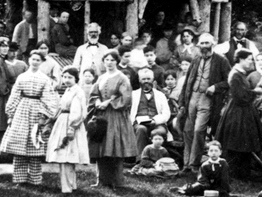
Thus, while residing at Oneida, J.H. Noyes fathered at least thirteen children with as many women members. Between 1848 and 1880, approximately 104 children were born into the commune (Teeple 1985:209). [Image at right]
Real property and money became joint property of the Community upon membership. However, legal title to real property, bank deposits, and debt was held by a small group of male leaders, including Noyes, Erastus Hamilton, William Woolworth, and Charles Kellogg (Charles A. Burt v. Oneida Community Ltd. 1889:195, 357).
Work was to be shared equally by commune members. Episodically and increasingly in later years, some members were critical of perceived evasion of duties by other members, and of the unequal distribution of property when the Community was liquidated. Most productive work was performed by scores of waged workers, in service at the Mansion House or as industrial labor in a modern water-powered factory adjacent to the Seneca Turnpike and the rail line connecting Utica and Syracuse. All waged workers were overseen by commune managers.
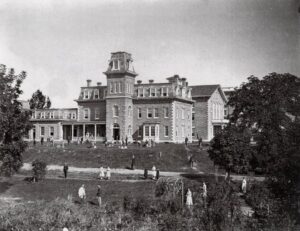
Community operations were sufficiently profitable in the 1850s and 1860s to support more than 300 individuals. Among other endeavors, revenue was used to enroll several male children in Yale University for advanced education in medicine, law, and biochemistry. Ostentatiously, between 1850 and 1877, the Community commissioned construction of three large Italianate and one Victorian Gothic residential buildings near the site of Burt’s original landholding. Eventually comprising 90,000 square feet, this Mansion House [Image at right] featured some of the latest conveniences including indoor plumbing and steam heat. Waged employees prepared meals and maintained living quarters and grounds.
ORGANIZATION/LEADERSHIP
The avowed structure of the Oneida Community was as an extended family that shared all work and its results. The Community’s “bible communism” took its inspiration from the Christian apostle Paul and Noyes’s interpretation of early Christian communities (Handbook 1867).
J.H. Noyes and close confidants considered him to be prime theologian and “spiritual father” of the commune, more perfect than others and in communication with divinity. Noyes sermonized during meetings and in essays published in Community newsletters. His exalted position was further actualized by his selection of community women as “stirpicultural” sexual partners.
Noyes was at the center of an inner circle of older men and women who had participated in the establishment of the Community in 1847. These included his sister, Jonathan Burt, George Cragin, Erastus Hamilton, William Hinds, John Miller, and a few others. In the 1860s, the central core group was Noyes, Hamilton, Burt, Cragin, with an orbiting group of supervisors responsible for specific operations. With the crash of 1873, the Community reorganized under a Business Board whose membership morphed as operations were started or stopped (Nordhoff 1875:278-80).
Community organizational coherence was reproduced in part through the practice of “mutual criticism,” whereby individual members behavior was collectively examined and critiqued. Mutual criticism reinforced conformity as well as recognized abnormalities within the commune, according to the guiding ideologies of commune leaders.
By the late 1850s, most of the productive work at the Oneida Community was performed by scores of waged workers, overseen by commune foremen and managers. Workers were recruited from surrounding subsistence farms and, as elsewhere in the industrializing northeast, were predominantly young women. Waged employees also serviced the living quarters and grounds of the Mansion House.
No existing records indicate whether members questioned the egality or fraternity of living off the waged labor of others, although narrators do describe an occasional paternalistic act as the beneficence of the Community bestowed upon one or another domestic worker, such as providing time off to get married, or scheduling work breaks so that the “mill girls” could bathe in the mill pond.
ISSUES/CHALLENGES
The Oneida Community shared some of the characteristics of other American nineteenth century communitarian experiments. The unity of will expressed by the ideology of Perfectionism was repeatedly challenged by internal and external stressors.
Internally, divergent perceptions and rationalizations of daily operations-as-politics and of strategic objectives-as-ideologies were bound to arise. The Community’s efforts to resolve those contradictions via the forum of “mutual criticism” were only intermittently successful. During the life of the commune, at least one-third of all adult joiners quit. Included in that group were several young adults born into the commune, suggesting that dissension was not solely imported from “the world” or an expression of prior understandings (“Ledger Showing Settlement, November–December 1880;” “Receipts and settlements with seceders 1855-1892;” Burt v. Oneida Community Ltd. 1889).
Externally, the commune was pushed and pulled by social forces (subsistence agriculture, industrialization, debt finance, plantation slave labor) and was increasingly at odds with those social forces. The sweeping change to industrialization brought about by U.S. civil war, the subsequent period of Reconstruction, and then the Great Depression of 1873-1880, undermined political and economic relationships in America, including those that had engendered communitarian experiments such as the Oneida Community. The “business communism” espoused by the leaders of the Community was undermined by dramatic changes in finance and debt, by newly capitalized competitors in industrial centers with better access to labor and capital, and by evolving public attitudes about class and gender roles. Thereby, the fundamental challenge to the communitarian premise of the Oneida Community was its operation as a capitalist enterprise. The Oneida Community attempted to coexist with the subsistence farmsteads that surrounded it but in unequal relationships: as a major buyer of farm produce and as a major employer of waged labor (Coffee 2019).
Especially after the Civil War transformed the U.S. economy, the Community faced an increasingly industrial and finance capitalist society. The Community simultaneously competed with and depended upon other actors in the regional, national and trans-oceanic economy. The equation by Noyes and other leaders of financial success with blessedness was subverted by those transformations and most dramatically so when the larger economy collapsed in the 1870s.
However, several alternate explanatory analyses have been presented since 1880 with which to frame our understanding of the Oneida Community’s dissolution.
Dominant among those is the official history written by Pierrepont Burt Noyes, one of J. H. Noyes’s “stirpiculture” children who became chief executive of the Oneida Community Limited corporation. Leaning heavily on his own class prejudice to undergird his father’s premise of a theological elite, the younger Noyes wrote several memoirs that glorified that legacy (e.g. Noyes 1937). As head of the OCL company, P. B. Noyes also commissioned an “official history” written by historical fiction writer Walter Edmonds (1948). Edmonds has been taken as given by many subsequent scholars. Most notable of Noyes’s and Edmond’s histories is the assertion that the joint-stock company (eventually a silverware manufacturer) was the logical continuation of the commune’s Perfectionist beliefs. Adding to the irony of that assertion is the fact that the Oneida Limited company became insolvent in the late 1990s and its trademark was sold to a competitor.
A second thread of inquiry traces a renewed interest among historians and social theorists in the internal dynamics of intentional communities as key events in nineteenth and twentieth century United States history. This thread was partly animated by later twentieth century social movements for equality in the United States and throughout the world. Robert S. Fogarty (1990) especially situates the Oneida Community within a continuum of intentional and counter-cultural communal experiments. Fogarty (Miller and Fogarty 2000) and Lawrence Foster (1992) have also explored the lives of women in the Oneida Community, complex marriage, and consensual adult sexual practices. Important in this examination is Fogarty’s edited publication of the dairy of female commune member Tirzah Miller (Miller and Fogarty 2000).
A third thread of examination is more specifically focused on the sexual practices of the Community, especially intergenerational relationships. Important contributors to that thread are, separately, Spencer Klaw (1993) and Ellen Wayland-Smith (2016). Although importantly distinct from each other, these authors each focus on sexual practices as personal psychologies. Wayland-Smith specifically situates the Community’s demise in its subordination of the individual personalities of Community youth.
Those who formed or joined the Oneida Community in its first years sought to escape the chaos of trans-Atlantic capitalist society, and they were attracted to John Humphrey Noyes’s charismatic profession of the alternative based on an extended cooperative family, the validity of which was taken from readings of the New Testament. The Noyesians sought to build a regime of reason and eternal justice out of their own theology, which explicitly linked religious fidelity with economic profit. Viewed through that lens, the commune’s economic decline complicated the distinction between good and evil, between perfect and imperfect souls. A theocracy that equated blessedness with wealth turned in on itself. Fellowship dissolved, pitting member against member.
IMAGES
Image #1: John Humphrey Noyes.
Image #2: Oneida community members circa 1860.
Image #3: An issue of the Oneida Circular.
Image #4: Front cover of Sexual Relations in the Oneida Community.
Image #5: John H. Noyes with his children.
Image #6: Mansion House
REFERENCES
American Socialist, 1877-1878. Oneida Community: Oneida, NY.
Charles A. Burt v. Oneida Community Ltd. New York State Supreme Court, Madison County, February 14, 1889.
Coffee, Kevin. 2019. “The Oneida Community and the utility of liberal capitalism.” Radical Americas 4:122.
Cooper, Matthew. 1987. “Relations of Modes of Production in Nineteenth Century America: The Shakers and Oneida.” Ethnology 26:1-16.
Edmonds, Walter D. 1948. The First Hundred Years. Oneida: OCL.
Miller, Tirzah and Robert S. Fogarty. 2000. Desire & Duty at Oneida. Bloomington, IN: Indiana University Press.
Foster, Lawrence. 1992. Women, Family, and Utopia. Syracuse NY: Syracuse University Press.
Handbook of the Oneida Community. 1867. Wallingford CT: Office of Oneida Circular.
Hinds, William Alfred. 1908. American Communities and Co-operative Colonies. Chicago: Charles H. Kerr.
Locke, John. 1768a. An Essay Concerning Human Understanding: Vol. 1. London: Woodfall.
Locke, John. 1768b. An Essay Concerning Human Understanding: Vol. 2. London: Woodfall.
‘Ledger Showing Settlement, November–December 1880’, Box 20, Oneida Community Collections, Special Collections Research Center, Syracuse University Libraries.
Klaw, Spencer. 1993. Without Sin. New York: Penguin.
Mill, John Stuart. 1866a. Principles of Political Economy, Volume 1. New York: Appleton & Co.
Mill, John Stuart. 1866b. Principles of Political Economy, Volume 2. New York: Appleton & Co.
Mill, John Stuart. 1863. On Liberty. Boston: Ticknor and Fields.
Mutual Criticism. 1876. Oneida NY: Office of the American Socialist.
Nordhoff, Charles. 1875. The Communistic Societies of the United States from Personal Visit and Observation, New York: Harper & Brothers.
Noyes, George Wallingford. 1931. John Humphrey Noyes, The Putney Community. Oneida: G.W. Noyes.
Noyes, John Humphrey. 1849 [1931]. “Bible Communism.” In John Humphrey Noyes, edited by G. W. Noyes, Oneida: G.W. Noyes.
Noyes, Pierrepont Burt. 1937. My Father’s House. New York: Holt Rinehart Winston.
Oneida Circular, 1872-1876. Oneida Community: Wallingford, CT and Oneida, NY.
Oneida Indian Nation (OIN). 2019. “Historical Timeline.” Accessed from https://www.oneidaindiannation.com/wp-content/uploads/2019/03/Historical-Timeline-2019.pdf on 15 April 2021.
“Our Books.” 1869. The Circular, February 8, 1869, 375-76.
Parker, Robert Allen. 1973 [1935]. A Yankee Saint. Hamden, CT: Archon Books.
“Receipts and settlements with seceders, 1855-1892,”’ Box 19, Oneida Community Collection, Special Collections Research Center, Syracuse University Libraries.
“Record of the proceedings of the Commission, 1880,” Box 19, Oneida Community Collection, Special Collections Research Center, Syracuse University Libraries
Robertson, Constance Noyes. 1970. Oneida Community. Syracuse, NY: Syracuse University Press.
The Circular, 1851-1870. Oneida Community: Brooklyn, NY and Oneida, NY.
Wayland-Smith, Ellen. 2016. Oneida. New York: Picador.
Wesley, John. 1844. Explanatory Notes upon the New Testament. New York: Lane & Sanford.
Wesley, John. 1840. Wesleyana: A Complete System of Wesleyan Theology. New York: Mason & Lane.
Wesley, John. 1827. The Works of John Wesley. New York: J & J Harper.
Teeple, John. 1985. The Oneida Family. Oneida, NY: Oneida Historical Association.
Publication Date:
17 April 2021
